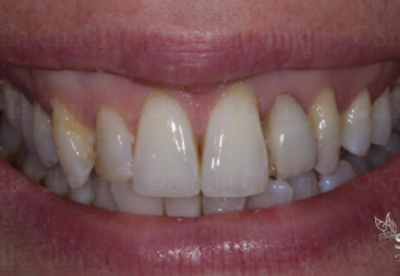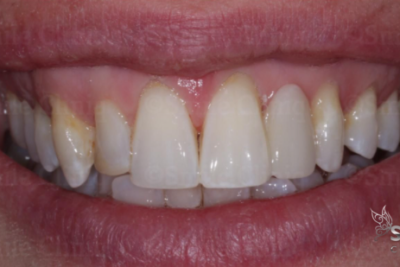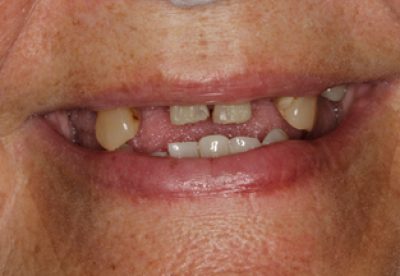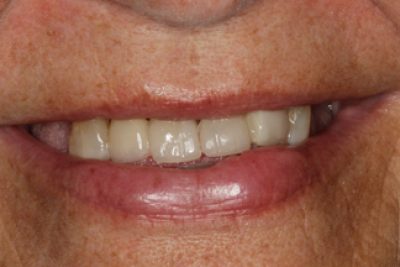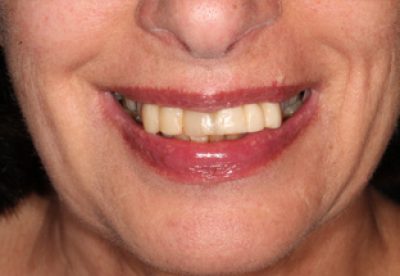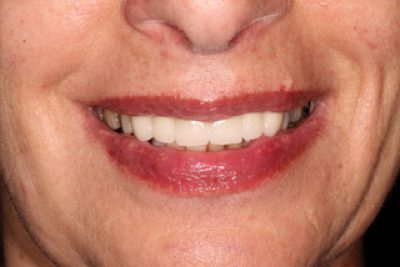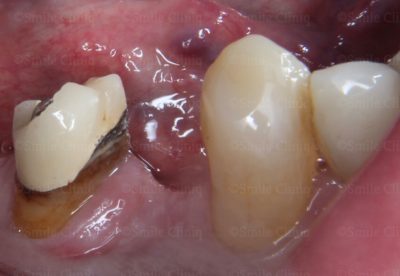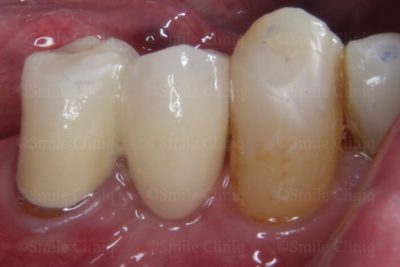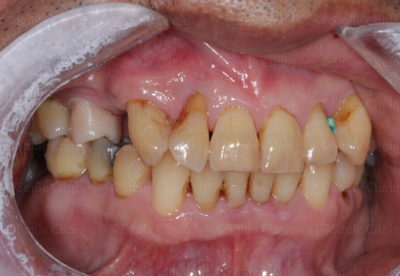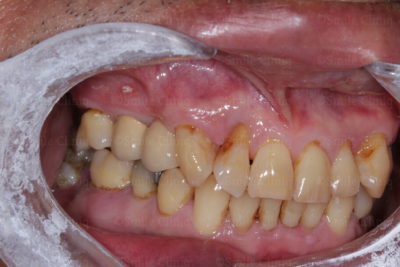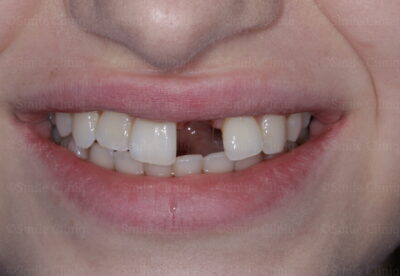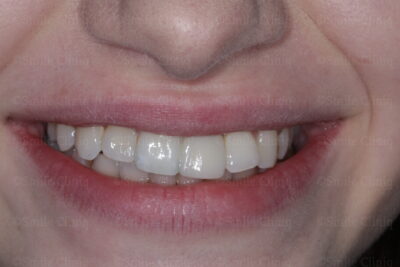Before and After Gallery
Dental Bridges London
Quality Dental Bridges From £250 per unit (Maryland) or £450 (Conventional).
Dental bridges are used to restore a gap created by one or more missing teeth; literally bridging the gap. Many types exist; in essence, they are all fixed and can only be removed by a dentist. Traditionally, bridges have relied on natural teeth to support them however, with advances in science and technology Smile Cliniq can now offer implant-supported dental bridges London, with the advantage of spanning larger gaps. Traditional dental bridge London treatments involve the preparation of the supporting teeth to receive a crown; the gap is closed upon cementation of the final bridge with life-like ceramic pontic. See our portfolio.
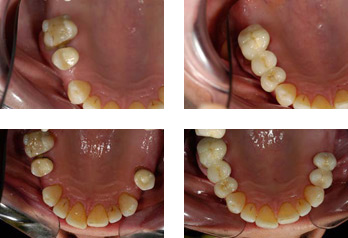
What are Dental Bridges London?
A dental bridge is a custom-made precision item that is cemented over your tooth or implant to completely cover it and restore an adjacent gap. Traditionally dental bridges have been described as ceramic fused to metal. Dental bridges of this nature are most frequently used. However advancing technology has provided materials based on Zirconium, which has eliminated the requirement for a metal substructure for your bridge. All ceramic bridges now are the gold standard in providing the ultimate aesthetic result.
Resin-bonded dental bridges are the quickest, most conservative, and cost-effective solution to restoring that gap in your smile. They rely on good quality and quantity of tooth substance to be present. A metal wing is bonded to an adjacent sound tooth, this carries an aesthetic custom-made ceramic tooth to bridge the gap in your smile.
Why are Dental Bridge London Treatments used?
Smile Cliniq Dental bridges London addresses both aesthetic and functional needs. Gaps at the front of your mouth provide a poor cosmetic appearance and affect speech and eating. Missing teeth further back in your mouth may provide significant limits to your diet. These reduce the pleasure and enjoyment associated with food and social occasions. Unstable, unsightly loose dentures have the potential to be replaced with a fixed bridge. Bridging that gap will provide you with a life-changing experience and the confidence to smile at all times.
Initial consultation, assessment and planning will occur with one of our dentists’. The options appropriate to your case will be thoroughly discussed with you. Preoperative pictures and tooth shade will be taken and the process is initiated. Impressions may be taken to allow our ceramist to provide a diagnostic wax-up, this will physically allow you to visualise and approve the intended outcome.
Advantages of Dental Bridges London
- Restoring a natural look to your mouth/smile
- Restoring the ability to speak normally, as missing teeth can impede proper enunciation
- Maintaining normal facial structure by preventing bone loss from the jaw at the site of the missing tooth/teeth
- Restoring the ability to chew food efficiently
- Preventing adjacent teeth from moving into the empty space, which can cause problems with your bite and lead to other complications
Disadvantages of Dental Bridges London
- Future damage to the abutment teeth can compromise the bridge.
- If the crowns are ill-fitting, bacteria and plaque may get inside and cause tooth decay.
- The crowns may change the structure of your teeth, affecting your bite.
- If the abutment teeth aren’t strong enough to support the bridge, the bridge could collapse.
- The abutment teeth may be weakened by the procedure(s) and have to be replaced by dental implants.
Maryland, Implant Retained and Conventional Dental Bridge London Treatments
Resin Bonded Dental Bridges (Maryland)
These require no or very little preparation of your tooth, therefore, negating the need for local anaesthetic. An impression will be taken of the tooth and sent to our ceramist along with your smile design and custom prescription. The Smile Cliniq ceramist follows your custom prescription to handcraft your bridge. This is then tried in and, after approval, cemented in. Resin-bonded bridges are cheaper than conventional bridges and involve fewer tooth preparations, but they do not last as long as the latter.
Implant Retained Dental Bridges
Implant retained bridges are the closest man-made item to replacing natural teeth. Many combinations of the implant-supported bridge are possible. Initial consultation, assessment and planning will occur with one of our dentists. The options appropriate to your case will be thoroughly discussed with you.
Conventional Dental Bridges London Smile Cliniq
The procedure for a traditional tooth-supported bridge follows that of a crown.

Types of Conventional Bridges
EMAX
Ivoclar Vivadent’s patented lithium disilicate material is truly a revolution for the dental industry. Never before has a material been able to combine high strength, high aesthetics and ease of use into one product, until now. IPS e.max is a lithium disilicate glass-ceramic that has optimized translucency, durability and strength for full anatomical restorations. Due to the use of new technologies and optimized processing parameters, IPS e.max lithium disilicate has evolved beyond previously available lithium disilicate ceramics. Indeed, compared to other glass ceramics, demonstrates a strength that is 2.5 to 3 times higher. IPS e.max lithium disilicate restorations exhibit superior durability featuring 360-400 MPa of flexural strength. When fabricated to full contour, the monolithic structure is the most robust ceramic system tested to date. The opalescence, translucency and light diffusion properties of IPS e.max lithium disilicate were all designed to replicate natural tooth structure for beauty and undetectable restorations.
Zirconia
Zirconia is the strongest crown material on the market today. The Zirconia material typically used by most manufacturers is tetragonal polycrystalline zirconia, partially stabilized with yttrium oxide. Zirconia materials typically have strengths of over 900 MPa.
Porcelain Bonded to Metal
White porcelain bonded to a metal substructure. The metal gives strength whilst the porcelain gives the white colour. Not as natural looking as Emax and gradia crowns. The metal substructure may be non–precious or precious metal depending on the patient’s choice. Precious metal is generally preferable as it is more biocompatible with the gingival (gums) leading to less inflammation and less risk of corrosion. The weak point here is the bond between the porcelain and metal, and over time the porcelain breaks off the metal. Also, as gums recede with age, a black line may be seen above the crown and this leads to an unsightly smile. This blackness is the metal in the crown. This does not occur with all-porcelain/ceramic crowns.
It is generally accepted that between 1 in 5 and 1 in 8 teeth crowned go on to become non-vital and require a root canal treatment at some stage and this can sometimes be many years after the initial crown.
Recall and Review
It may take a couple of days for you to become accustomed to your new bridge. You will be invited to return a few weeks after your dental bridge London fitting to review your oral health status, condition of the bridge and feedback on the cosmetic result of the dental bridge London treatment. It is important to employ a strict oral hygiene regime encompassing professional hygiene intervention, as a bridge will not protect natural teeth from decay or gum disease. You will be shown the most appropriate method to ensure optimal oral health. As with any treatment regular recall and review is essential to ensure the optimal status of your bridge.
It is generally accepted that between 1 in 5 and 1 in 8 teeth crowned go on to become non-vital and require a root canal treatment at some stage and this can sometimes be many years after the initial crown. Get in touch with our dentist in London today.
Dental Bridges London FAQs
How many teeth can you have on a dental bridge London?
Generally, the maximum number of missing teeth that can be bridged between two supporting teeth or implants is four, but this will be influenced by the factors already mentioned. A bridge can also be more extensive and restore multiple gaps between more than two teeth or implants.
Is a dental bridge London better than an implant?
If you’re missing more than one consecutive tooth, a dental bridge is likely a better option than an implant. A separate implant needs to be surgically attached to your jawbone for each missing tooth, leading to expensive and often impractical surgery.
Is a dental bridge London procedure painful?
The bridge procedure is not painful because a local anaesthetic is used while paring your teeth and when your dentist takes an impression. It is often unnecessary to take any pain relief after the treatment.
Can you eat with dental bridges London?
It is normally not difficult to eat with a dental bridge, particularly if the bridge is fixed and not removable. This type of dental bridge is sealed to the support teeth, which are connected to the fake tooth (crown).
Even more Information and Consent- Please click here for our fees guide.
- Please click here for examples of our work
- For further details of our techniques, materials and techniques please click here.
- Please click here for our guide to maintaining your oral hygiene.
- Interest free payment options are available
- Return to the top of the page










Finchley
020 3582 8621
St Johns Wood
020 3627 8732
Smile Cliniq Limited. A company registered in England and Wales. Company number 08279068.
Registered office: C/O TG Associates 7 Jardine House, Harrovian Business Village, Bessborough Road, Harrow, Middlesex, HA1 3EX
Terms of Use | Privacy Policy | Health & Safety Charter | Complaints procedure | Data Protection | Cookie Settings
Website by Digimax Dental









